The City of Prince George will include a review of the city’s tree protection bylaw during the planned update of the city’s official community plan next year, following a vote by city council on Monday.
The move came after two groups of UNBC environmental studies students presented their research on urban trees and the importance of greenspace to city council, at Monday’s regular council meeting.
The city’s tree protection bylaw dates back to 1995, with an update in 2012. The bylaw only applies to areas designated greenbelt and some riparian zones near watercourses.
“Currently the protected areas are limited and disconnected,” UNBC student Ben Gadd said. “We are not here to discourage investment and development, but to encourage tree retention is considered in all (proposed developments).”
The students proposed expanding the protected areas under the bylaw, include tree protection measures in other municipal bylaws, work with arborists and city planners to update the city’s recommended tree list, and recognize the importance of green space for residents – including reducing the “urban heat island” effect.
The city’s recommended tree list should prioritize species native to the area, student Riana Smith said. The current list includes a large number of eastern Canadian and eastern U.S. species, as well as an invasive species, Smith added.
Student King’ori Mwangi said the city should look to communities like the City of Kamloops and Town of Gibsons for more modern and effective examples of tree protection bylaws. Some things done by other communities include requiring that trees removed are replaced at a two-for-one ratio, that developers provide a security deposit to cover costs of tree replacement, and mandatory horticultural reviews of major development projects.
'MAINTAINING GREENSPACE...SAVES MONEY'
Greenspace is more than just trees, however, UNBC professor Annie Booth said.
“Greenspace is one of those things that are undervalued, until they are done,” Booth said. “And then you can’t get them back.”
Booth and her students provided a report on the value of greenspace, based on existing literature and small surveys of UNBC students, faculty and staff.
According to the Pembina Institute, Canada’s forests provide $93.2 billion per year in “ecosystem services” from increased property values to flood and landslide control.
“Maintaining greenspace saves the city and taxpayers’ money, and we would like this to be considered,” UNBC student Ashley Yorston said.
The tourism and mental health benefits of urban greenspace have been well-studied and proven, student Jerek Postuk added.
The students called on the city to promote denser, mixed-use developments to retain the city’s remaining greenspaces as much as possible. The students’ research will be forwarded to city staff for consideration during the city’s official community plan review.
“The tree protection bylaw, we certainly recognize in the department, is dated – it’s (almost) 30 years old,” city director of planning and development Deanna Wasnik said.
Coun. Cori Ramsay said she does a lot of recruitment and retention planning as part of her day job, and things like environment and greenspace are especially important to younger workers. As a city, those younger workers are “the people we want to keep in Prince George,” she said.
“Younger people are more engaged in the environment than previous generations,” Ramsay said.
Coun. Brian Skakun said there will be a lot of competing priorities when the city reviews the official community plan in 2023, and encouraged the students and those interested in the issue to take part in the process.



